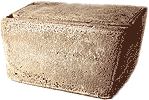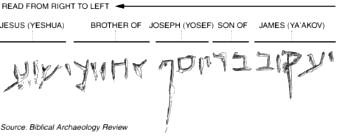|
V RaptureChrist Newsletter
|
||||
The discovery of the ossuary of James, brother of Jesus, our Messiah, is the most exciting development in the history of New Testament archeology. This ancient relic has been called 'the most important extra-biblical evidence of its kind.' It was found south of the Mount of Olives, in the town of Silwan, a densely settled Arab village full of subterranean Jewish burial caves dating from the 1st century. According to the ossuary's owner, a Jerusalem Jewish archeological collector, the dealer who sold it to him told him that it was unearthed in the 1970's from a cave in the Silwan area.  French scholar Andre Lemaire,
from the University of La Sorbonne, believes that this 1st century burial box, which measures approximately 20 x 10 x 12
inches, is the
first archaeological proof of the existence of our Lord Jesus. French scholar Andre Lemaire,
from the University of La Sorbonne, believes that this 1st century burial box, which measures approximately 20 x 10 x 12
inches, is the
first archaeological proof of the existence of our Lord Jesus.
To assess the box's composition, Hershel Shanks, editor of the Biblical Archaeology Review, sent it to be examined. Scientists from the Geological Survey of Israel determined that the ossuary was made of a limestone quarried from the Mount Scopus ridge (which includes the Mount of Olives in Jerusalem). They dated it to the 1st or 2nd century A.D., noting that the undisturbed cauliflower-shaped structure of its patina indicated that it had spent centuries in a cave, confirming its antiquity and ruling out forgery. The inscription on the box reads from right to left "Yaakov bar Yosef akhui di Yeshua" which in English translates to "James, son of Joseph, brother of Jesus." The language of the inscription is the Aramaic spoken by Jews in Jerusalem in the 1st century A.D.
The words are so simple that any Hebrew reader would be able to understand what it says.
There are 3 possibilities to spell the name
"yeshua": the three letter Yeshu The old editions of the Talmud, compiled by
rabbis during the 3rd to 6th centuries A.D., referred to Jesus as
Yeshua If we look at James' ossuary, the name is
spelled Yeshua To find the name of a brother in the obituary of the deceased is rather odd; it would only be done if that brother was well known by the community, just as Jesus was. The box contains small bone fragments, the largest one measuring three inches by half inch. These fragments will stay in Jerusalem, but the ossuary will be sent to Canada this month. The Royal Ontario Museum (ROM), located in Toronto, Canada, announced recently that the James Ossuary will be placed on exhibit in the Mediterranean World Feature Exhibition Gallery by Saturday, November 16, 2002 and remain until Sunday, December 29, 2002. Remember Jesus words about the stones: Luke 19:40 Yes, James' stone burial box is crying out to us the truth about our
Messiah. |
According to the Gospels, James was one of the brothers of Jesus. Matthew 13:55 Mark 6:3 But Jesus' brothers did not believe in Him till after the resurrection. John 7:5 Christ appeared to his brother James soon after his resurrection. 1 Corinthians 15:7 Seven week after the resurrection, at the time of Pentecost, when all of Jesus' followers were meeting in the temple, we find Jesus' brothers were also there. Acts 1:14 After his conversion, James became the leader of the church in Jerusalem. Galatians 1:19 Peter, after escaping from prison, leaves a message for James and the Apostles at the home of Mary the mother of John. By mentioning James' name first, he implies the preeminence of James over the other brethren. Acts 12:17 James, Peter, and John are considered "the pillars" of the Christian church. James is mentioned first, meaning he had higher standing among the brethren. Galatians 2:9 James wrote the Epistle of James. James 1:1 James was of a similar mentality to his brother Jesus in keeping the law. When Jesus was asked "What shall I do to inherit eternal life?" He said: Matthew 19:17 James 2:17 |
|||

